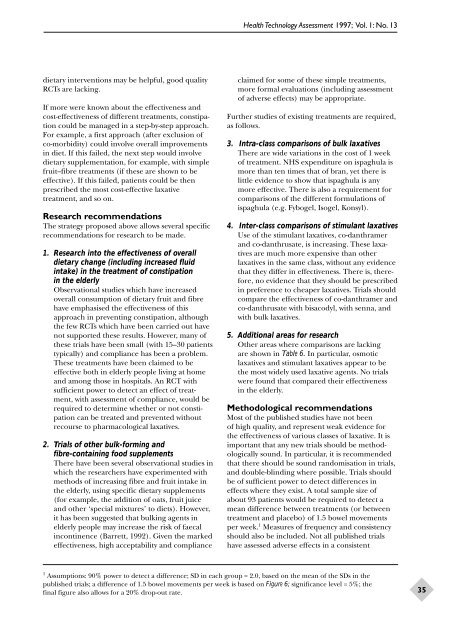Effectiveness of Laxatives in the Elderly - NIHR Health Technology ...
Effectiveness of Laxatives in the Elderly - NIHR Health Technology ...
Effectiveness of Laxatives in the Elderly - NIHR Health Technology ...
You also want an ePaper? Increase the reach of your titles
YUMPU automatically turns print PDFs into web optimized ePapers that Google loves.
dietary <strong>in</strong>terventions may be helpful, good quality<br />
RCTs are lack<strong>in</strong>g.<br />
If more were known about <strong>the</strong> effectiveness and<br />
cost-effectiveness <strong>of</strong> different treatments, constipation<br />
could be managed <strong>in</strong> a step-by-step approach.<br />
For example, a first approach (after exclusion <strong>of</strong><br />
co-morbidity) could <strong>in</strong>volve overall improvements<br />
<strong>in</strong> diet. If this failed, <strong>the</strong> next step would <strong>in</strong>volve<br />
dietary supplementation, for example, with simple<br />
fruit–fibre treatments (if <strong>the</strong>se are shown to be<br />
effective). If this failed, patients could be <strong>the</strong>n<br />
prescribed <strong>the</strong> most cost-effective laxative<br />
treatment, and so on.<br />
Research recommendations<br />
The strategy proposed above allows several specific<br />
recommendations for research to be made.<br />
1. Research <strong>in</strong>to <strong>the</strong> effectiveness <strong>of</strong> overall<br />
dietary change (<strong>in</strong>clud<strong>in</strong>g <strong>in</strong>creased fluid<br />
<strong>in</strong>take) <strong>in</strong> <strong>the</strong> treatment <strong>of</strong> constipation<br />
<strong>in</strong> <strong>the</strong> elderly<br />
Observational studies which have <strong>in</strong>creased<br />
overall consumption <strong>of</strong> dietary fruit and fibre<br />
have emphasised <strong>the</strong> effectiveness <strong>of</strong> this<br />
approach <strong>in</strong> prevent<strong>in</strong>g constipation, although<br />
<strong>the</strong> few RCTs which have been carried out have<br />
not supported <strong>the</strong>se results. However, many <strong>of</strong><br />
<strong>the</strong>se trials have been small (with 15–30 patients<br />
typically) and compliance has been a problem.<br />
These treatments have been claimed to be<br />
effective both <strong>in</strong> elderly people liv<strong>in</strong>g at home<br />
and among those <strong>in</strong> hospitals. An RCT with<br />
sufficient power to detect an effect <strong>of</strong> treatment,<br />
with assessment <strong>of</strong> compliance, would be<br />
required to determ<strong>in</strong>e whe<strong>the</strong>r or not constipation<br />
can be treated and prevented without<br />
recourse to pharmacological laxatives.<br />
2. Trials <strong>of</strong> o<strong>the</strong>r bulk-form<strong>in</strong>g and<br />
fibre-conta<strong>in</strong><strong>in</strong>g food supplements<br />
There have been several observational studies <strong>in</strong><br />
which <strong>the</strong> researchers have experimented with<br />
methods <strong>of</strong> <strong>in</strong>creas<strong>in</strong>g fibre and fruit <strong>in</strong>take <strong>in</strong><br />
<strong>the</strong> elderly, us<strong>in</strong>g specific dietary supplements<br />
(for example, <strong>the</strong> addition <strong>of</strong> oats, fruit juice<br />
and o<strong>the</strong>r ‘special mixtures’ to diets). However,<br />
it has been suggested that bulk<strong>in</strong>g agents <strong>in</strong><br />
elderly people may <strong>in</strong>crease <strong>the</strong> risk <strong>of</strong> faecal<br />
<strong>in</strong>cont<strong>in</strong>ence (Barrett, 1992). Given <strong>the</strong> marked<br />
effectiveness, high acceptability and compliance<br />
<strong>Health</strong> <strong>Technology</strong> Assessment 1997; Vol. 1: No. 13<br />
claimed for some <strong>of</strong> <strong>the</strong>se simple treatments,<br />
more formal evaluations (<strong>in</strong>clud<strong>in</strong>g assessment<br />
<strong>of</strong> adverse effects) may be appropriate.<br />
Fur<strong>the</strong>r studies <strong>of</strong> exist<strong>in</strong>g treatments are required,<br />
as follows.<br />
3. Intra-class comparisons <strong>of</strong> bulk laxatives<br />
There are wide variations <strong>in</strong> <strong>the</strong> cost <strong>of</strong> 1 week<br />
<strong>of</strong> treatment. NHS expenditure on ispaghula is<br />
more than ten times that <strong>of</strong> bran, yet <strong>the</strong>re is<br />
little evidence to show that ispaghula is any<br />
more effective. There is also a requirement for<br />
comparisons <strong>of</strong> <strong>the</strong> different formulations <strong>of</strong><br />
ispaghula (e.g. Fybogel, Isogel, Konsyl).<br />
4. Inter-class comparisons <strong>of</strong> stimulant laxatives<br />
Use <strong>of</strong> <strong>the</strong> stimulant laxatives, co-danthramer<br />
and co-danthrusate, is <strong>in</strong>creas<strong>in</strong>g. These laxatives<br />
are much more expensive than o<strong>the</strong>r<br />
laxatives <strong>in</strong> <strong>the</strong> same class, without any evidence<br />
that <strong>the</strong>y differ <strong>in</strong> effectiveness. There is, <strong>the</strong>refore,<br />
no evidence that <strong>the</strong>y should be prescribed<br />
<strong>in</strong> preference to cheaper laxatives. Trials should<br />
compare <strong>the</strong> effectiveness <strong>of</strong> co-danthramer and<br />
co-danthrusate with bisacodyl, with senna, and<br />
with bulk laxatives.<br />
5. Additional areas for research<br />
O<strong>the</strong>r areas where comparisons are lack<strong>in</strong>g<br />
are shown <strong>in</strong> Table 6. In particular, osmotic<br />
laxatives and stimulant laxatives appear to be<br />
<strong>the</strong> most widely used laxative agents. No trials<br />
were found that compared <strong>the</strong>ir effectiveness<br />
<strong>in</strong> <strong>the</strong> elderly.<br />
Methodological recommendations<br />
Most <strong>of</strong> <strong>the</strong> published studies have not been<br />
<strong>of</strong> high quality, and represent weak evidence for<br />
<strong>the</strong> effectiveness <strong>of</strong> various classes <strong>of</strong> laxative. It is<br />
important that any new trials should be methodologically<br />
sound. In particular, it is recommended<br />
that <strong>the</strong>re should be sound randomisation <strong>in</strong> trials,<br />
and double-bl<strong>in</strong>d<strong>in</strong>g where possible. Trials should<br />
be <strong>of</strong> sufficient power to detect differences <strong>in</strong><br />
effects where <strong>the</strong>y exist. A total sample size <strong>of</strong><br />
about 93 patients would be required to detect a<br />
mean difference between treatments (or between<br />
treatment and placebo) <strong>of</strong> 1.5 bowel movements<br />
per week. 1 Measures <strong>of</strong> frequency and consistency<br />
should also be <strong>in</strong>cluded. Not all published trials<br />
have assessed adverse effects <strong>in</strong> a consistent<br />
1 Assumptions: 90% power to detect a difference; SD <strong>in</strong> each group = 2.0, based on <strong>the</strong> mean <strong>of</strong> <strong>the</strong> SDs <strong>in</strong> <strong>the</strong><br />
published trials; a difference <strong>of</strong> 1.5 bowel movements per week is based on Figure 6; significance level = 5%; <strong>the</strong><br />
f<strong>in</strong>al figure also allows for a 20% drop-out rate.<br />
35
















